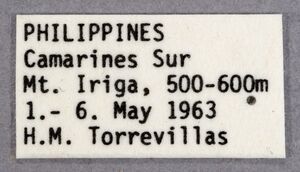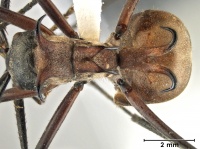Polyrhachis mindanaensis
| Polyrhachis mindanaensis | |
|---|---|

| |
| Scientific classification | |
| Kingdom: | Animalia |
| Phylum: | Arthropoda |
| Class: | Insecta |
| Order: | Hymenoptera |
| Family: | Formicidae |
| Subfamily: | Formicinae |
| Tribe: | Camponotini |
| Genus: | Polyrhachis |
| Subgenus: | Polyrhachis |
| Species group: | bihamata |
| Species: | P. mindanaensis |
| Binomial name | |
| Polyrhachis mindanaensis Emery, 1923 | |
Polyrhachis mindanaensis appears to be endemic to the Philippines, with its occurrence confirmed from nine islands; Batan, Leyte, Luzon, Mindoro, Mindanao, Negros, Palawan, Panay, Samar (Dave General, pers. com.). (Kohout, 2014)
Identification
A member of the bihamata group of the subgenus Polyrhachis.
Hung (1970) raised P. mindanaensis to specific status, considering it to be a morphological intermediate between Polyrhachis bihamata and Polyrhachis ypsilon. It features a combination of characters from both species but, apart from the widely divergent petiolar spines, most of the characters suggest it to be closer to P. bihamata. Polyrhachis mindanaensis also somewhat resembles Polyrhachis maliau, with distinguishing characters given in the remarks section under the latter. (Kohout, 2014)
Keys including this Species
Distribution
Latitudinal Distribution Pattern
Latitudinal Range: 38.453° to 7.42062°.
| North Temperate |
North Subtropical |
Tropical | South Subtropical |
South Temperate |
- Source: AntMaps
Distribution based on Regional Taxon Lists
Indo-Australian Region: Philippines (type locality).
Distribution based on AntMaps
Distribution based on AntWeb specimens
Check data from AntWeb
Countries Occupied
| Number of countries occupied by this species based on AntWiki Regional Taxon Lists. In general, fewer countries occupied indicates a narrower range, while more countries indicates a more widespread species. |

|
Estimated Abundance
| Relative abundance based on number of AntMaps records per species (this species within the purple bar). Fewer records (to the left) indicates a less abundant/encountered species while more records (to the right) indicates more abundant/encountered species. |

|
Biology
Castes
Male and immature stages unknown.
   
| |
| . | Owned by Museum of Comparative Zoology. |
     
| |
| . | |
- Queen
    
| |
| . | |
Nomenclature
The following information is derived from Barry Bolton's Online Catalogue of the Ants of the World.
- mindanaensis. Polyrhachis (Polyrhachis) ypsilon var. mindanaensis Emery, 1923: 62 (w.) PHILIPPINES. Raised to species: Hung, 1970: 20.
Unless otherwise noted the text for the remainder of this section is reported from the publication that includes the original description.
Description
Worker
Hung (1970) - Lectotype: (Herein designated from a syntype in the collection of Museo Civico di Storia Naturale). HW 2.25 mm, HL 2.62 mm, cr 86, SL 3.40 mm, SI 151, PW 1.25 mm, MPL 2.67 mm, MTL 4.57 mm, PSEI 151, PH 2.50 mm. Median ocellus present, no lateral ocelli. Pronotum somewhat flat but without traceable margins. Pronotal spines stouter than in Polyrhachis bihamata, only black at tip. Mesonotum with two spines pyramidal in shape, closer together than in ypsilon, but not as in bihamata. Metanotal groove present Propodeum with horizontal ridge between basal face and the declivity but without traceable margines along the sides.
Kohout (2014) - (paralectotypes cited first): TL c. 11.44 – 11.89, 10.94-12.10; HL 2.67 – 2.70, 2.62 – 2.77; HW 2.32, 2.32 – 2.47; CI 86 – 87, 85 – 91; SL 3.43 – 3.58, 3.28 – 3.63; SI 148 – 154, 141 – 154; PW 1.31, 1.16 – 1.31; PeH 2.57, 2.57 – 2.97; PeI 95 – 96, 95 – 107; MTL 4.89 – 4.99, 4.74 – 5.19 (3+12 measured).
Queen
Kohout (2014) - TL c. 13.91; HL 2.87*; HW 2.62*; CI 91*; SL 4.28; SI 163; PW 2.97; PeH 1.21; PeI 42; MTL 5.34 (1 measured) (* measurements only approximate due to the partly damaged head of the single available queen).
Queen distinctly larger than worker and with usual characters identifying full sexuality, including three ocelli, complete thoracic structure and wings. Mandibles with four teeth; apical tooth much longer than subapical tooth, with 3rd and 4th teeth rather vestigal. Clypeus damaged in single available specimen. Eyes larger than in worker; sides of head in front of eyes weakly converging towards mandibular bases; behind eyes, sides widely rounding into occipital margin. Frontal carinae sinuate with distinctly raised margins; central area with distinct frontal furrow. Pronotal humeri rounded without indication of pronotal spines. Mesoscutum virtually wide as long; lateral margins converging anteriorly into only moderately rounded anterior margin; median line distinct; parapsides flat; mesoscutum in profile rather high, anterior face widely rounding onto almost flat, relatively short dorsum. Mesoscutellum moderately convex, only marginally elevated above dorsal plane of mesosoma. Propodeal dorsum immarginate, convex in outline, about 2× as long as weakly concave declivity; posterior angles only poorly raised as medially directed, blunt ridges, propodeal dorsum between them descending into declivity in medially uninterrupted line. Petiole with pair of relatively short, widely diverging, dorsoposteriorly directed spines with extreme tips curved backwards.
Mandibles finely longitudinal striate with piliferous pits. Head, mesosoma and petiole very finely reticulate-punctate; extreme tips of petiolar spines smooth and polished. Gaster shagreened.
Mandibles at masticatory borders with several curved golden hairs. Anterior clypeal margin with a few longer setae medially and fringe of marginally shorter setae laterally. Generally abundant, moderately long, golden hairs on all dorsal body surfaces, including petiole and appendages; antennal scapes with a few, rather short, hairs along leading edge. Closely appressed, rich golden pubescence in various densities over most body surfaces, except tips of petiolar spines; pubescence on dorsum of gaster with distinct reddish tint.
Colour. Black, with only light reddishbrown blotch along pronotal margin; dorsal margins of femora and gaster medium to dark reddish-brown.
Type Material
Kohout (201) - Syntype workers (lectotype and paralectotypes designated by Hung, 1970: 20). Type locality: PHILIPPINES, MINDANAO, Zamboanga (W. Schultze), MSNG, DEIE (examined).
References
- Baltazar, C.R. 1966. A catalogue of Philippine Hymenoptera (with a bibliography, 1758-1963). Pacific Insects Monographs 8: 1-488. (page 279, listed)
- Emery, C. 1923a. Einige exotische Ameisen des Deutschen Entomologischen Institutes. Entomol. Mitt. 12: 60-62 (page 62, worker described)
- Hung, A. C. F. 1970. A revision of ants of the subgenus Polyrhachis Fr. Smith (Hymenoptera: Formicidae: Formicinae). Orient. Insects 4: 1-36 (page 20, Raised to species)
- Kohout, R.J. 2014. A review of the subgenus Polyrhachis (Polyrhachis) Fr. Smith (Hymenoptera: Formicidae: Formicinae) with keys and description of a new species. Asian Myrmecology 6, 1–31.
- Zettel, H. 2019. Two new species from Malaysia and further taxonomic notes on Polyrhachis s.str. (Hymenoptera: Formicidae). Zeitschrift der Arbeitsgemeinschaft Österreichischer Entomologen 71: 57-73.
References based on Global Ant Biodiversity Informatics
- Figueras G. S., and O. M. Nuneza. 2013. Species diversity of ants in karst limestone habitats in Bukidnon and Davao Oriental, Mindanao, Philippines. Advances in Environmental Sciences - International Journal of the Bioflux Society 5(3): 306-315.
- Hung A. C. F. 1970. A revision of ants of the subgenus Polyrhachis Fr. Smith (Hymenoptera: Formicidae: Formicinae). Oriental Insects 4(1): 1-36.
- Kohout R. J. 2014. A review of the subgenus Polyrhachis (Polyrhachis) Fr. Smith (Hymenoptera: Formicidae: Formicinae) with keys and description of a new species. Asian Myrmecology 6: 1-31.
- Robson Simon Database Polyrhachis -05 Sept 2014

